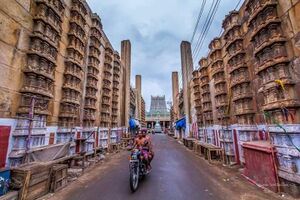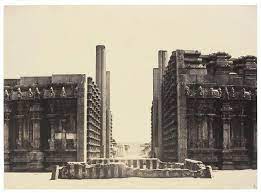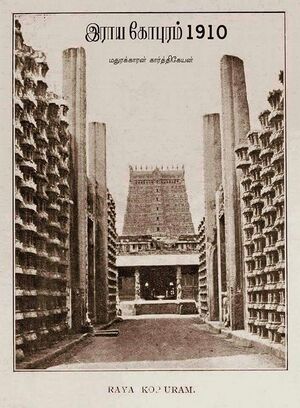Raya Gopuram (Madurai)
இந்தப் பக்கத்தை தமிழில் வாசிக்க: இராய கோபுரம் (மதுரை)
The Raya Gopuram, Madurai (1654-1659) is the foundation of an unfinished gopuram (tower) near the Madurai Meenakshi Amman temple. The construction of the Raya Goguram was begun by Thirumalai Nayakkar, who was one of the rulers of Madurai. The gopuram is situated outside the Madurai Meenakshi Amman temple in the eastern end of the Aavani Moola Street, at the entrance of the Yezhukadal Veedhi (Seven Seas Street). The first floor of this gopuram is 18 meters high, twice the size of the first floors of other gopurams in the Madurai temple complex. When completed, the Raya Gopuram would have been the biggest gopuram in South India.
Etymology
The word 'Raya' means stone in Telugu. Since the gopuram is made of stone or rocks, it is called Raya Gopuram. Thirumalai Nayakkar was called 'Rayar' and it could be that the gopuram was named after him.
Documentation
Photographer Linnaeus Tripe's book Photographic Views in Madurai (Madras, 1858) contains the oldest available picture of Madurai's unfinished gopuram. This picture was taken in 1858.
History
Thirumalai Nayakar completed the construction of the new mandapam (hall) inside the Meenakshi Amman temple in 1654. Following this, he started constructing the Raya Gopuram in the Avani Moola street. The new mandapam and the Raya Gopuram were constructed as part of the Madurai Meenakshi Amman temple complex.
It is said that Thirumalai Nayakkar wanted to construct similar gopurams in the 64 Saiva, Vaishnava (Shiva, Vishnu) temples. These temples, spread across the area from Uttathur to Kanyakumari were under the control of the Madurai Nayakkar government. It is believed that the foundations of many of these temples were laid during his era and completed by the rulers who came later. However, no strong evidence is available to prove this.
Construction
The Thiruvannamalai Rajagopuram (217 feet) was the tallest gopuram in Tamil Nadu when the Madurai Raya Gopuram's construction began. Thirumalai Nayakkar aspired to build a gopuram taller than the former. The height of Madurai Raya Gopuram's kalhaara (foundation) was 50 feet, its length, 170 feet and width, 110 feet. Experts on tower craft speculate that the Madurai Raya Gopuram's height would have been 300 feet had it been completed. Thirumalai Nayakkar began the construction of the Raya Gopuram in 1654. Owing to his illness at the age of 70 and the economic crisis in Madurai, the construction was suspended in 1659, the year of his death.
Structure of the Gopuram
The gopuram or its base structure as it stands today is 18 meters tall, with a ten feet substructure underground and 35 feet tall structure above ground. The base structure is adorned with sculptures, unlike other similar gopurams, and each pillar is made from a single stone. The Raya Gopuram is built along the lines of Dravidian architecture and contains intricate carvings of Bhoota Ganangal, Madhanigas and Gandharvas along with rows of flower garlands and Shivalingas. At the entrance of the gopuram there are life size sculptures of Thirumalai Nayakar, his minister, Sokkapar and a temple dancer, Ponnaiyal.
Current State
Madurai Raya Gopuram remains abandoned as an architectural landmark. It has since been defaced by those who have converted the space into petty shops by building temporary structures using bamboo and screen cloth, and hanging objects on nails driven into this structure. Even buildings conjoined to the base structure of the unfinished gopuram have been constructed. The Raya Gopuram is now inaccessible as it has become a congested commercial area.
About
J. P. L. Shenoy I. C. S., the Commissionership of Madurai remarks in his book, Kovil Nagaram Madurai, "This would’ve been one of the greatest buildings in India if it had been completed."
Nearby Archeological Sites
Historical landmarks such as Pathu Thoon and Thirumalai Nayakkar Mahal are situated near the Raya Gopuram.
Reference
- Madurai Nayakar's History, A. K. Paranthamanar
Links
- Tamil Virtual University
- Madurai Raya Gopuram- Vikatan article.
- Current State of Raya Gopuram
- Story of Madurai Raya Gopuram
- Incomplete Roya Gopura (tower), Madurai Meenakshi temple
✅Finalised Page



